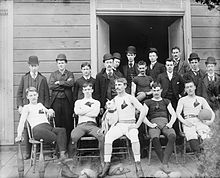History of American football
The history of football can be traced to early versions of rugby and association football. Both games have their origins in varieties of football played in the United Kingdom in the mid-19th century, in which a ball is kicked at a goal and/or run over a line. Many games known as "football" were being played at colleges and universities in the United States in the first half of the 19th century.[3][4] Rutgers University and its neighbor, Princeton University, played the first game of intercollegiate football on 6 November 1869 on a plot of ground where the present-day Rutgers gymnasium now stands in New Brunswick, New Jersey, following rules closely resembling modern soccer. Rutgers won that first game, 6-4.[5] Rugby-style games were introduced to the United States in 1871 when an international match between Harvard's football team and one out of McGill University in Montreal featured a game of rugby and a game played according to Harvard's house rules. The rugby-style game, still prototypical at the time (and yet to separate into the union and league variants seen today), would become the starting point for the American (and Canadian) game in the late 19th century. Walter Camp Football resulted from several major divergences from rugby football, most notably the rule changes instituted by Walter Camp, considered the "Father of Football."[6] Among these important changes were the introduction of the line of scrimmage and of down-and-distance rules. In the late 19th and early 20th centuries, game play developments by college coaches such as Eddie Cochems, Amos Alonzo Stagg, Knute Rockne, and Glenn "Pop" Warner helped take advantage of the newly introduced forward pass. The popularity of collegiate football grew as it became the dominant version of the sport for the first half of the twentieth century. Bowl games, a college football tradition, attracted a national audience for collegiate teams. Bolstered by fie

ce rivalries, college football still holds widespread appeal in the US.[3][7][8] The origin of professional football can be traced back to 1892, with William "Pudge" Heffelfinger's $500 contract to play in a game for the Allegheny Athletic Association against the Pittsburgh Athletic Club. Pittsburgh's football circuit became fully professional over the course of the 1890s, culminating in the first professional league, the Major League Baseball-backed National Football League of 1902, which folded after one season. The core of professional football moved westward into Ohio beginning in 1903, where it would remain until a mass dispersal throughout the midwest in the late 1910s. In 1920, the American Professional Football Association was formed as a coalition of teams from regional state associations such as the Ohio League and the New York Pro Football League. The first game was played in Dayton, Ohio on October 3, 1920 with the host Triangles defeating the Columbus Panhandles 14–0. The league changed its name to the National Football League (NFL) two years later; from its inception, the NFL had been the de facto major league of football. Initially a sport of Midwestern industrial towns in the United States, professional football eventually became a national phenomenon. Football's increasing popularity is usually traced to the 1958 NFL Championship Game, a contest that has been dubbed the "Greatest Game Ever Played". A rival league to the NFL, the American Football League (AFL), began play in 1960; the pressure it put on the senior league led to a merger between the two leagues and the creation of the Super Bowl, which has become the most watched television event in the United States on an annual basis.[9] Other professional leagues, both major (or at least attempting to be major) and minor, have formed but almost all have been short-lived. High school football dates to the 1880s and enjoys regional popularity.